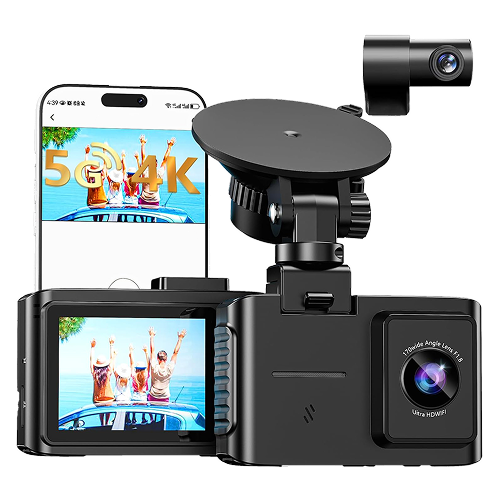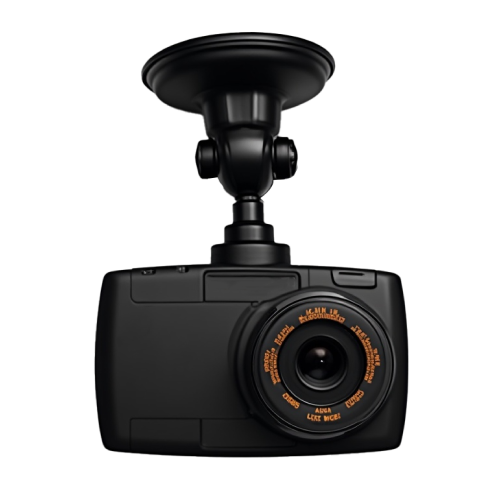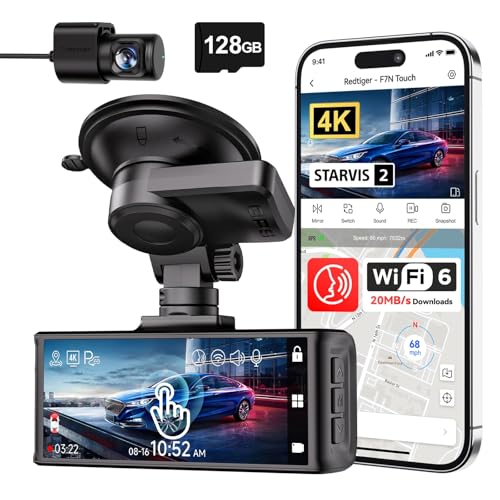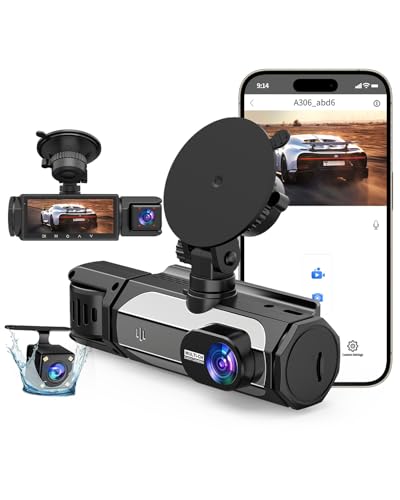A dash cam is essential technology to keep an eye out for what’s in front of a vehicle and to capture videos and other information in case of an accident. If you want to capture both what’s in front of your vehicle as well as either what’s behind or inside, you’ll want to choose a dual-camera dash cam, also known as a dual-channel dash cam.
As the name implies, a dual-camera dash cam comes with two cameras and is available in two varieties. The first type uses a separate camera that can be mounted on the rear window or other part of a vehicle to capture a rear view. The second type includes a second camera as part of the front-facing dash cam to record the interior of a vehicle.
While both types of second cameras have different applications they serve the same purpose: to capture video that a single front-facing camera can’t. A separate camera mounted at the rear of a vehicle captures images in the event of a rear end collision or activity around the rear of the vehicle when a dash cam is in parking mode. A second interior-facing camera captures activity inside the car and is often used by ride-share or other professional drivers in case they need evidence of an incident.
While dual-camera dash cams share many features with other dash cams, which you can read about in our main dash cam buyer’s guide, when shopping for a dual-camera dash cams there are specific features and specs you should look for that I detail below.
Key Features for Dual Camera Dash Cams
Image Sensor
An image sensor converts light entering the camera lens into digital video or photos. In dash cams, the sensor’s quality is crucial since it needs to capture fast-moving vehicles, road signs, and license plates clearly, even in difficult lighting.
A dual-camera dash cam uses two sensors, one for the front and one for the rear, so both need to deliver sharp and balanced footage.
Look for dash cams that use high-quality CMOS sensors (such as Sony STARVIS or Exmor) for better clarity and color accuracy in both bright daylight and low light. A good sensor helps preserve detail when driving at speed or at night.
You should also make sure your dash cam supports Wide Dynamic Range (WDR) or High Dynamic Range (HDR).
- WDR is a hardware-based system that captures several images at different exposures, then merges them into one balanced shot. It helps retain detail in bright skies and dark shadows, like when driving at sunrise or through tunnels.
- HDR is a software-based enhancement that improves brightness and color range for a more natural-looking image.
Some models offer both (like the Pelsee P1 and Kenwood DRV-A610WDP) using WDR for the front camera and HDR for the rear to optimize footage from each angle.
Resolution
Video resolution determines how much detail your dash cam can capture. It’s expressed in pixels and directly affects the sharpness of your footage. Common resolutions include 720p (HD), 1080p (Full HD), 2K (Quad HD), and 4K (Ultra HD).
For dual-camera systems, you’ll often see two resolution specs—one for each camera. Look for at least 1080p on both cameras for usable, detailed footage. If you want to capture finer details like license plates in low light, consider 2K or 4K options.
Keep in mind that higher resolutions require more storage space and processing power, which can raise the price and fill up memory cards faster. If budget or file size is a concern, a mix of 4K front and 1080p rear is a smart balance.
Parking Mode
Parking mode lets your dash cam monitor your car while it’s parked. This feature is ideal for spotting hit-and-run incidents, vandalism, or suspicious activity.
Make sure your dash cam supports hardwiring to your car’s electrical system, since this allows continuous power even when the ignition is off. A dedicated hardwire kit is usually required.
There are several types of parking modes:
- Impact detection: The dash cam wakes up and records when the G-sensor detects a bump or vibration.
- Time-lapse mode: Captures still frames every few seconds for a condensed video summary of parked activity.
- Radar or motion detection: Uses radar or AI to distinguish between genuine threats (like someone peering into the car) and harmless movements (like tree branches).
If you want remote access, look for models with cloud or LTE connectivity. These can send smartphone notifications and let you view footage live or after an alert.
Dual-camera dash cams are especially useful for parking surveillance because the rear camera can capture what happens behind your car—something single-lens models miss. Interior-facing cameras can also be helpful for ride-share drivers or those parking in public areas.
Night Vision
Night vision enhances your dash cam’s ability to record in low light or complete darkness. It typically uses infrared (IR) lighting, which allows the camera to see without visible light, though footage appears in black and white.
For clearer results in dark conditions, look for dash cams featuring Super Night Vision or enhanced low-light sensors. For instance, the 70mai 4K A800S combines improved optics and image processing to produce brighter, sharper night footage.
Also check whether your dash cam uses WDR or HDR, as both improve visibility in scenes with bright headlights or deep shadows.
In short: Choose a dash cam with advanced low-light technology if you often drive at night or park in poorly lit areas.
Popular Brands and Types of Dual-Camera Dash Cams
BlackVue
Pros:
- Premium build and image quality. Their dual-channel models (e.g., the DR900X-2CH) offer 4K front / Full HD rear options and good low light performance.
- Strong ecosystem: options like cloud connectivity (remote access) add value.
- Good brand reputation among users looking for high-end features and reliability.
Cons:
- Price is higher than many budget or mid-tier models.
- Some premium features may require additional accessories (hard-wiring for parking mode, cloud subscription) which add to total cost.
- Overkill for someone wanting a simple front+rear camera without advanced extras.
Viofo
Pros:
- Excellent value for image quality. Models like the A229 Pro offer dual Sony STARVIS sensors, 4K front + 2K rear, strong low-light performance.
- Balanced between cost and performance—good choice if you care about image clarity and detail but don’t want ultra-luxury budget.
- Good support for serious dash-cam users (parking mode options, large memory card support).
Cons:
- Fewer “luxury” extras compared with top tier brands (cloud services, full smartphone integration) in some models.
- You may need to purchase additional hardware for full features (e.g., hard-wire kit) independently.
- Installation and setup might be a bit more hands-on (for best parking mode, etc).
Thinkware
Pros:
- Strong emphasis on safety features and parking-mode performance (motion & impact detection) alongside video quality.
- Good reputation for reliability and supporting features like Super Night Vision, GPS, built-in alerts.
- Balanced models (mid-to-high tier) that suit serious everyday drivers, not just enthusiasts.
Cons:
- While good, peak image resolution may not always match ultra-top brands (depending on the model).
- Feature set may cost more compared with simpler dual-cams with equivalent resolution.
- Some advanced features may be “nice to have” rather than strictly necessary for basic driving use.
Nextbase
Pros:
- Good balance of features and ease of use. Models such as the 622GW (dual) deliver 4K front + Full HD rear, with smart features like voice control, WiFi, GPS.
- User-friendly interface, good build quality, strong brand presence in mainstream market.
- Easier to install and operate for everyday drivers rather than tech-enthusiasts.
Cons:
- Rear-camera resolution and overall specs may be a step down compared with “enthusiast” dual-cams. (In 622GW the rear was 1080p only)
- Some features may be more “lifestyle” than strictly the best image/capture quality (so if you need the sharpest license-plate capture in low light you might get a better value brand).
- Higher-end features in this brand may cost more than some similarly spec’d models from lesser known brands.












